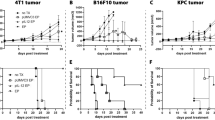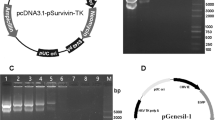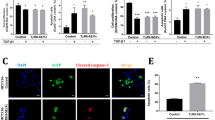Abstract
One of the major obstacles in current cancer gene therapy is the lack of a gene delivery system with high efficiency and targetability. In this paper, a nonviral gene delivery system GE7, which was designed to target EGF receptor (EGF R) overexpressed on the surface of cancer cells through an EGF R–binding oligopeptide (GE7), was used for in vivo gene therapy in a murine subcutaneous hepatoma model. It was demonstrated that the GE7 system could target the reporter gene β-gal to EGF R–expressing hepatoma cells with high efficiency after in vitro transfection and in vivo peritumoral injection. To improve the therapeutic effect elicited by single gene transfer, human cyclin-dependent kinase inhibitor gene p21WAF-1 and murine cytokine gene GM-CSF were used simultaneously in peritumoral injection of the GE7/DNA polyplex. The results showed that combined gene transfer of p21WAF-1 and GM-CSF could inhibit the growth of pre-established tumor more effectively and prolong the survival time of hepatoma-bearing mice more significantly than the transfer of a single gene. Apoptosis in the tumor tissues were found when injected with the p21WAF-1 DNA polyplex. Prominent inflammatory infiltration was observed in the tumor tissue transfected with the GM-CSF DNA polyplex. Our data demonstrate that the GE7 system–mediated, EGF R–targeted cotransfer of p21WAF-1 and GM-CSF genes exhibit more potent antitumor effect by inducing tumor cell apoptosis and inflammatory responses.
This is a preview of subscription content, access via your institution
Access options
Subscribe to this journal
Receive 12 print issues and online access
$259.00 per year
only $21.58 per issue
Buy this article
- Purchase on Springer Link
- Instant access to full article PDF
Prices may be subject to local taxes which are calculated during checkout







Similar content being viewed by others
References
Cristiano RJ, Roth JA . Epidermal growth factor mediated DNA delivery into lung cancer cells via the epidermal growth factor receptor Cancer Gene Ther 1996 3: 4–10
Foster BJ, Kern JA . HER2-targeted gene transfer Hum Gene Ther 1997 8: 719–727
Frederiksen KS, Abrahamsen N, Cristiano RJ et al. Gene delivery by an epidermal growth factor/DNA polyplex to small cell lung cancer cell lines expressing low levels of epidermal growth factor receptor Cancer Gene Ther 2000 7: 262–268
Mohr L, Yoon SK, Eastman SJ et al. Cationic liposome-mediated gene delivery to the liver and to hepatocellular carcinomas in mice Hum Gene Ther 2001 12: 799–809
Tian PK, Ren SJ, Ren CC et al. A novel receptor-targeted gene delivery system for cancer gene therapy Sci China Ser C Life Sci 1999 42: 216–224
Li JM, Han JS, Huang Y et al. A novel gene delivery system targeting cells expressing VEGF receptors Cell Res 1999 9: 11–25
Hamazaki K, Yunoki Y, Tagashira H et al. Epidermal growth factor receptor in human hepatocellular carcinoma Cancer Detect Prev 1997 21: 355–360
Dilloo D, Bacon K, Holden W et al. Combined chemokine and cytokine gene transfer enhances antitumor immunity Nat Med 1996 2: 1090–1095
Roth JA, Swisher SG, Meyn RE . p53 tumor suppressor gene therapy for cancer Oncology 1999 13: 148–154
Ju DW, Tao Q, Cheng DS et al. Adenovirus-mediated lymphotactin gene transfer improves therapeutic efficacy of cytosine deaminase suicide gene therapy in established murine colon carcinoma Gene Ther 2000 7: 329–338
Rogulski KR, Zhang K, Kolozsvary A et al. Pronounced antitumor effects and tumor radiosensitization of double suicide gene therapy Clin Cancer Res 1997 3: 2081–2088
Aruga A, Tanigawa K, Aruga E et al. Enhanced adjuvant effect of granulocyte–macrophage colony-stimulating factor plus interleukin-12 compared with either alone in vaccine-induced tumor immunity Cancer Gene Ther 1999 6: 89–95
Sandig V, Brand K, Herwig S et al. Adenovirally transferred p16INK4/CDKN2 and p53 genes cooperate to induce apoptotic tumor cell death Nat Med 1997 3: 313–319
Putzer BM, Bramson JL, Addison CL et al. Combination therapy with interleukin-2 and wild-type p53 expressed by adenoviral vectors potentiates tumor regression in a murine model of breast cancer Hum Gene Ther 1998 9: 707–718
Cao X, Huang X, Ju DW et al. Enhanced antitumoral effect of adenovirus-mediated cytosine deaminase gene therapy by induction of antigen-presenting cells through stem cell factor/granulocyte–macrophage colony-stimulating factor gene transfer Cancer Gene Ther 2000 7: 177–186
McKenzie PP, Guichard SM, Middlemas DS et al. Wild-type p53 can induce p21 and apoptosis in neuroblastoma cells but the DNA damage-induced G1 checkpoint function is attenuated Clin Cancer Res 1999 5: 4199–4207
Joshi US, Chen YQ, Kalemkerian GP et al. Inhibition of tumor cell growth by p21WAF1 adenoviral gene transfer in lung cancer Cancer Gene Ther 1998 5: 183–191
Ren CC, Tian PK, Qu SM et al. Expression of cyclin-dependent kinase inhibitor genes induces apoptosis in human hepatoma cell line Chin Sci Bull 1997 42: 2000–2005
Dranoff G, Jaffee E, Lazenby A et al. Vaccination with irradiated tumor cells engineered to secrete murine granulocyte–macrophage colony-stimulating factor stimulates potent, specific, and long-lasting anti-tumor immunity Proc Natl Acad Sci USA 1993 90: 3539–3543
Burger JA, Baird SM, Powell HC et al. Local and systemic effects after adenoviral transfer of the murine granulocyte–macrophage colony-stimulating factor gene into mice Br J Haematol 2000 108: 641–652
Cao X, Ju DW, Tao Q et al. Adenovirus-mediated GM-CSF gene and cytosine deaminase gene transfer followed by 5-fluorocytosine administration elicit more potent antitumor response in tumor-bearing mice Gene Ther 1998 5: 1130–1136
Cao X, Zhang W, Wang J et al. Therapy of established tumour with a hybrid cellular vaccine generated by using granulocyte–macrophage colony-stimulating factor genetically modified dendritic cells Immunology 1999 97: 616–625
Ju DW, Cao X, Acres B . Intratumoral injection of GM-CSF gene encoded recombinant vaccinia virus elicits potent antitumor response in a mixture melanoma model Cancer Gene Ther 1997 4: 139–144
Murata M, Kagiwada S, Takahashi S et al. Membrane fusion induced by mutual interaction of the two charge-reversed amphiphilic peptides at neutral pH J Biol Chem 1991 266: 14353–14358
Su W, Yeong KF, Spencer J . Immunohistochemical analysis of human CD5 positive B cells: mantle cells and mantle cell lymphoma are not equivalent in terms of CD5 expression J Clin Pathol 2000 53: 395–397
Burnette WN . “Western blotting”: electrophoretic transfer of proteins from sodium dodecyl sulfate — polyacrylamide gels to unmodified nitrocellulose and radiographic detection with antibody and radioiodinated protein A Anal Biochem 1981 112: 195–203
Johnson DH . Locally advanced, unresectable non-small cell lung cancer: new treatment strategies Chest 2000 117: 123S–126S
Ghosh SS, Takahashi M, Thummala NR et al. Liver-directed gene therapy: promises, problems and prospects at the turn of the century J Hepatol 2000 32: 238–252
Chow NH, Tzai TS, Cheng HL et al. The clinical value of p21WAF1/CIP1 expression in superficial bladder cancer Anticancer Res 2000 20: 1173–1176
Rich JN, Zhang M, Datto MB et al. Transforming growth factor-beta–mediated p15(INK4B) induction and growth inhibition in astrocytes is SMAD3-dependent and a pathway prominently altered in human glioma cell lines J Biol Chem 1999 274: 35053–35058
Kobayashi S, Shirasawa H, Sashiyama H et al. P16INK4a expression adenovirus vector to suppress pancreas cancer cell proliferation Clin Cancer Res 1999 5: 4182–4185
Warren TL, Weiner GJ . Uses of granulocyte–macrophage colony-stimulating factor in vaccine development Curr Opin Hematol 2000 7: 168–173
Hunter T, Pines J . Cyclins and cancer. II: cyclin D and CDK inhibitors come of age Cell 1994 79: 573–582
Waldman T, Zhang Y, Dillehay L et al. Cell-cycle arrest versus cell death in cancer therapy Nat Med 1997 3: 1034–1036
Lowe SW, Ruley HE, Jacks T, Housman DE . p53-dependent apoptosis modulates the cytotoxicity of anticancer agents Cell 1993 74: 957–967
Symonds H, Krall L, Remington L et al. p53-dependent apoptosis suppresses tumor growth and progression in vivo Cell 1994 78: 703–711
Fisher DE . Apoptosis in cancer therapy: crossing the threshold Cell 1994 78: 539–542
Hogge GS, Burkholder JK, Culp J et al. Preclinical development of human granulocyte–macrophage colony-stimulating factor–transfected melanoma cell vaccine using established canine cell lines and normal dogs Cancer Gene Ther 1999 6: 26–36
Mach N, Gillessen S, Wilson SB et al. Differences in dendritic cells stimulated in vivo by tumors engineered to secrete granulocyte–macrophage colony-stimulating factor or Flt3-ligand Cancer Res 2000 60: 3239–3246
Chang AE, Li Q, Bishop DK et al. Immunogenetic therapy of human melanoma utilizing autologous tumor cells transduced to secrete granulocyte–macrophage colony-stimulating factor Hum Gene Ther 2000 11: 839–850
Hiltbold EM, Alter MD, Ciborowski P et al. Presentation of MUC1 tumor antigen by class I MHC and CTL function correlate with the glycossylation state of the protein taken Up by dendritic cells Cell Immunol 1999 194: 143–149
Tamada K, Shimozaki K, Chapoval AI et al. Modulation of T-cell–mediated immunity in tumor and graft-versus-host disease models through the LIGHT co-stimulatory pathway Nat Med 2000 6: 283–289
Acknowledgements
We thank Dr. Jingjun Li for pathological section preparation and immunohistochemistry analysis and Dr. Dian-Wen Ju for his helpful discussion. This work was supported by a grant of Biotechnology Project, National High Technology Program of China (Project No. Z-20-01-01).
Author information
Authors and Affiliations
Corresponding authors
Rights and permissions
About this article
Cite this article
Liu, X., Tian, P., Yu, Y. et al. Enhanced antitumor effect of EGF R–targeted p21WAF-1 and GM-CSF gene transfer in the established murine hepatoma by peritumoral injection. Cancer Gene Ther 9, 100–108 (2002). https://doi.org/10.1038/sj.cgt.7700400
Received:
Published:
Issue Date:
DOI: https://doi.org/10.1038/sj.cgt.7700400
Keywords
This article is cited by
-
Enhanced efficiency and specificity of ovarian cancer gene therapy in rats with a novel nonviral gene delivery system (GE7) via intraovarian artery perfusion approach
Cancer Gene Therapy (2005)
-
Gene therapy of hepatocarcinoma: a long way from the concept to the therapeutical impact
Cancer Gene Therapy (2003)
-
Systemic genetic transfer of p21WAF−1 and GM-CSF utilizing of a novel oligopeptide-based EGF receptor targeting polyplex
Cancer Gene Therapy (2003)



